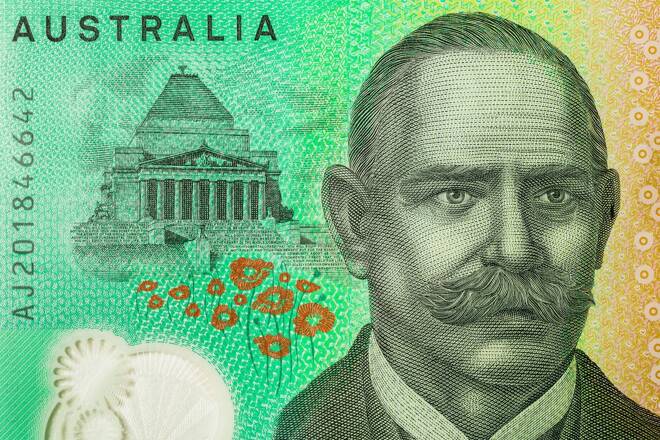Advertisement
Advertisement
AUD/USD Daily Forecast: Will China’s Economic Data Weigh on the Aussie Dollar?
By:
Key Points:
- Chinese profit forecasts are weaker, signaling lower AUD demand, impacting Aussie exports and GDP growth.
- Australia’s labor market at risk if China demand wanes, threatening wage growth and consumer spending.
- US consumer confidence data crucial for AUD/USD, affecting Fed’s rate path.
Will China’s Profit Data Shake the Aussie Dollar?
Industrial profit numbers from China, out on Tuesday, August 27, will impact buyer demand for the AUD/USD pair.
Economists forecast industrial profits will increase by 3.3% year-to-date, year-on-year, in July, slightly down from 3.5% in June.
A fall in industrial profit trends could signal deteriorating demand, possibly impacting the Australian economy. With a trade-to-GDP ratio above 50%, Australia may experience dampened export growth and lower contributions to GDP from trade.
Additionally, 20% of the Australian workforce is in trade-related jobs, exposing the labor market to demand shifts from China. A weakening demand environment may impact wage growth and consumer spending, which accounts for over 50% of GDP.
Private Consumption, Inflation, and the RBA Rate Path
On Wednesday, August 28, the Australian Monthly CPI Indicator could be crucial for the RBA rate path and the Aussie dollar. Economists expect the inflation rate to drop from 3.8% in June to 3.4% in July.
Softer-than-expected inflation figures could reduce investor bets on a Q4 RBA rate hike. A drop in inflation and a sharp fall in Chinese industrial profits could enable the RBA to adjust its forward guidance.
Despite these concerns, investors expect the interest rate differential between the US and Australia to narrow, favoring the Aussie dollar. Unless the data from China and Australia are particularly weak, the AUD/USD pair is likely to continue its move toward $0.70.
Expert Views on China and the RBA Rate Path
AMP Head of Investment Strategy and Chief Economist Shane Oliver commented on the Chinese economy, stating,
“China new property sales remain weak as does steel demand and production.”
Judo Bank Chief Economic Advisor Warren Hogan recently remarked on the August PMI Survey and the RBA rate path, stating,
“There is nothing in these results that allows us to reduce the probability that the RBA may still have to raise the cash rate further before a concerted easing cycle can begin.”
US Economic Calendar
Later in the session on Tuesday, consumer confidence and house price trends will draw investor interest. While the housing sector is a litmus test of the US economy, consumer confidence is likely to have a more significant impact on the Fed rate path.
CB Consumer Confidence and Private Consumption
Economists predict the CB Consumer Confidence Index will fall modestly from 100.3 in July to 100.1 in August.
A sharp drop in consumer confidence could indicate reduced consumer spending, possibly impacting the US economy since it contributes over 70% to GDP. While the headline figure is influential, consumer sentiment toward the US labor market may affect the Fed rate path more, given the intensifying scrutiny of the labor market.
Expert Views on the US Labor Market and Economy
On Friday, Arch Capital Chief Global Economist Parker Ross considered the US labor market and Fed rate path, stating,
“The Fed has never started a mid-cycle adjustment with the unemployment rate already on the upswing y/y… But I hear there are too many rate cuts priced in!”
Ross elaborated on his Friday remarks, saying,
“This is why I emphasized on Friday that we’ve never been this far into the deterioration of the labor market prior to Fed rate cuts. The Fed is putting a lot of faith in its ability to turn the economy around, despite little historical evidence that it has such an ability.”
Short-Term Forecast: Bullish
Near-term AUD/USD trends will depend on economic indicators from China and Aussie inflation figures. Weaker-than-expected numbers could slow the AUD/USD push toward $0.70. However, Weak US data could fuel bets on a more dovish Fed rate path. A narrowing of the interest rate differential would support an AUD/USD return to $0.70.
Investors should remain alert to economic data and central bank commentary influencing AUD/USD price trends. Monitor the real-time data, news updates, and expert commentary to adjust your trading strategies.
Stay updated with our latest views and analysis to manage exposures to the forex markets.
AUD/USD Price Action
Daily Chart
The AUD/USD remains comfortably above the 50-day and 200-day EMAs, confirming the bullish price trend.
A break above the $0.67967 resistance level could signal a return to $0.68500. Furthermore, a breakout from $0.68500 may bring the $0.68996 resistance level into play.
Investors should consider the data from China, US consumer confidence, and central bank comments.
Conversely, a drop below $0.67500 could bring the $0.67003 support level into play. A fall through the $0.67003 support level may signal a drop to the top trend line and the 50-day EMA. Buying pressure may intensify at the top trend line. The 50-day EMA is confluent with the top trend line.
With a 14-period Daily RSI reading of 64.61, the Aussie dollar could break above the $0.67967 resistance before entering overbought territory.
About the Author
Bob Masonauthor
With over 28 years of experience in the financial industry, Bob has worked with various global rating agencies and multinational banks. Currently he is covering currencies, commodities, alternative asset classes and global equities, focusing mostly on European and Asian markets.
Latest news and analysis
Advertisement
